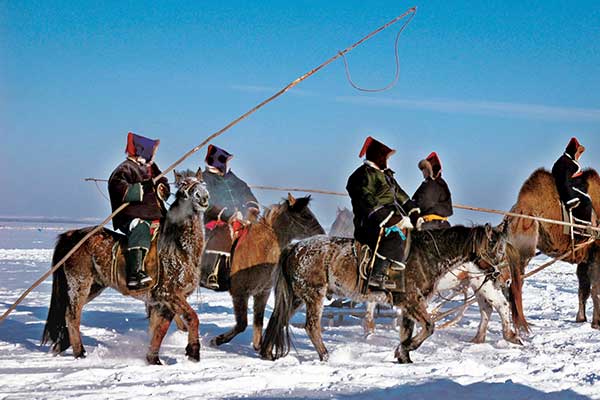
Ethnic Mongolian herdsmen stage a lassoing competition in Hulunbuir in the Inner Mongolia autonomous region.(Photo provided to China Daily)
Sun Island's annual international snow-sculpture expo upped the ante with such architectural creations as a 50-meter-high Russian church.
Light shows and fireworks encouraged night visits.
Three of Yabuli's mountain ski tracks were connected, and new bunny hills were completed this year.
Xuexiang introduced recreational-vehicle campsites.
Heilongjiang launched five winter routes late last year, starting from Harbin and continuing to other regions.
"We want to ride the wave of the successful 2022 Winter Olympics bid to encourage more people from the south to visit Heilongjiang and experience its winter tourism," Hou says.
The local government is working to design interprovincial courses with Inner Mongolia, Jilin and Liaoning.
An emphasis on integrating ethnic customs-camel beauty pageants, nighttime dance parties among livestock and yurt stays-with sublime snowscapes has enthused Inner Mongolia's wintertime influx.
"Scenic spots and hotels stayed closed during winter a few years ago," says Dong Limin, head of the region's tourism authority's tourism promotion department.
"But they've remained open over the past two winters to cater to demand."
The region received 3.3 million visits over Spring Festival, up nearly 12 percent year-on-year.
Eastern areas, such as Hulun Buir, Hinggan and Xilingol, host horse races, hot springs and slopes. The warmer west, including the capital, Hohhot, enables outdoor activities like temple fairs, lantern shows and religious rituals.
In Lengjicun, known as "China's coldest village" in Inner Mongolia's Genhe city, where temperatures dive below -40 C, visitors enjoy tossing hot water from glasses to see it freeze into "frost flowers" midair, Dong says.
Aoluguya offers deer encounters. Arxan and the Greater Hinggan Mountains shine with rime.
Inner Mongolia's local government plans to expand ski resorts, and the Matryoshka Plaza, featuring Russian restaurants and art performances.
"We'll support locals offering household catering and accommodation services," Dong says.
Despite its general lack of snow, even Beijing saw an 8.6 percent increase over last year's visits to ski resorts.
Hebei province's Chongli county's visits increased by over 17 percent to 180,000 tourists, who mostly came to ski.
Even southern China received more snow-seeking tourists.
January's international children's ski festival at Xilin Snow Mountain in Sichuan province's capital, Chengdu, helped it become southern China's hottest winter tourism spot, says a report from Chinese online travel-service provider Lvmama.
The report explains those born in the '80s have been the major force behind winter tourism.
Qin says he'll explore other frigid destinations if his son maintains interest in winter sports.
The recent cold months' visitor records suggest he's far from alone in the icy seasons to come.
China has caught winter fever.


















































